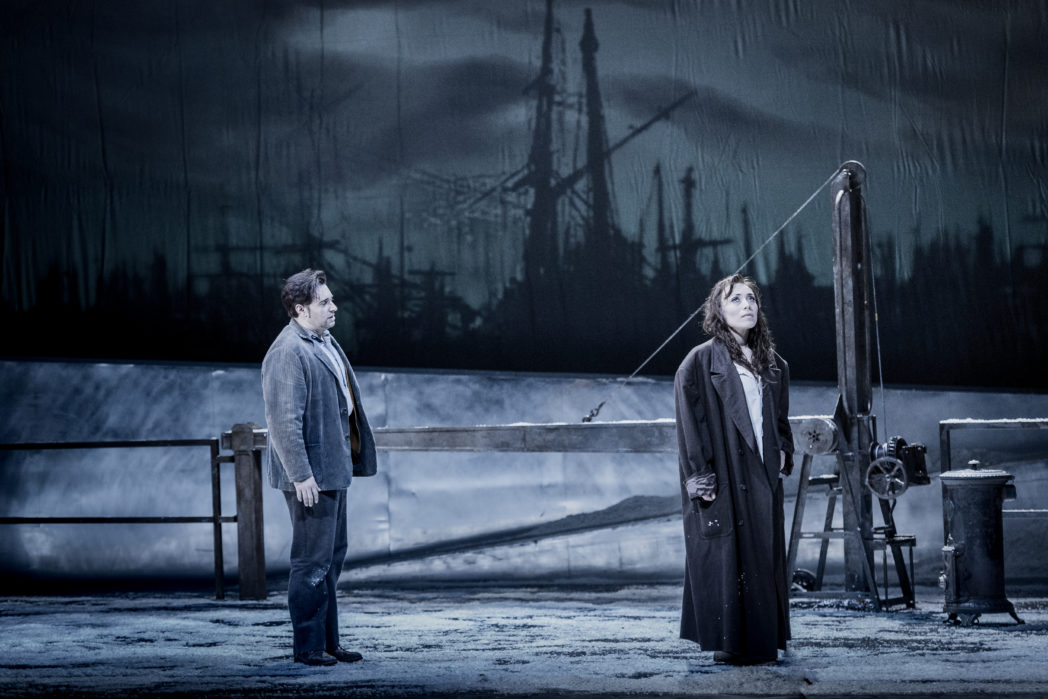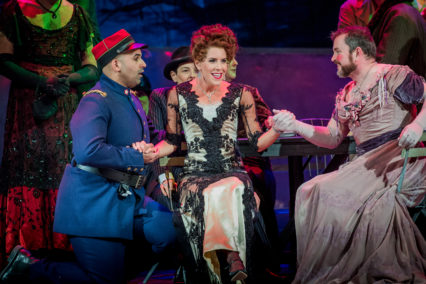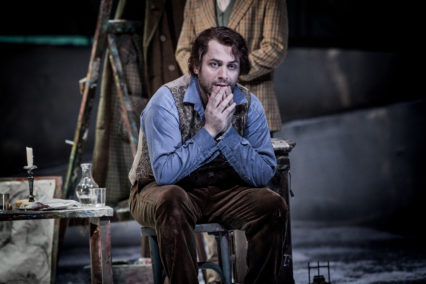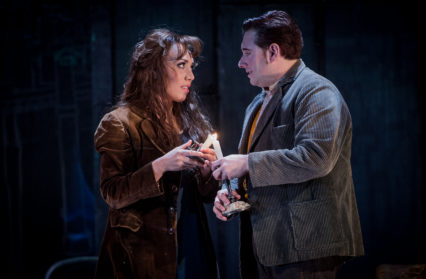It’s instructive to learn how time can alter one’s view of an opera production. When Annabel Arden’s version of La bohème for WNO opened five years ago, it was notable among other important things for its overlaid video images and its updating from around 1830 to 1913. Nina Dunn’s videos were non-abstract, except perhaps for the swirling weather indicated beyond the bohemians’ garret window. They included smoke rising from chimneys, fireworks, flocks of pigeons in flight, and real snow flurries to beef up the fake sort scattered from the theatre flies. At first, all these seemed superfluous to scenes already verismo by definition.
Now, perhaps because we’ve become used to cinematic enhancement in the theatre, the added visuals seem scarcely worth mentioning; Arden may even have employed them to remind us that the opera’s action is all too real. That she made it so, without being tempted to overdress with ‘meaning’ (the modern opera director’s insistent prerogative), allowed Dunn’s embellishments to slot in neatly. On the opening night in June 2012, the pigeons flying across the scenes of merriment at the Café Momus in act two resulted in a momentary tableau. Since then, revivals have de-frosted it at the edges. Sitting outside, the café’s Christmas Eve clientèle must have felt pretty parky anyway, and no gathering in Paris has ever been stalled by a sudden flapping of bird wings. At the time it seemed indicative of a portent, of the coming of global conflict.

Shunting the action forwards eighty-three years must have been significant. But what did the ante-bellum references denote? In 1830, Europe was buzzing with internal strife fifteen years after the end of the Napoleonic wars, and the happy-go-unlucky arty types might have become agitators. It was forty years before the mercilessly swift Franco-Prussian war. The original setting probably never suggested this. Arden, however, with effective but unadorned sets by Stephen Brimson Lewis and some gloomily-restrained lighting by Tim Mitchell, must have viewed the opera as one which, in the ‘madcap’ decade that opened the 20th century, mirrored an historical seismic shift. Millions would die and a culture, not least the nascent culture of Modernism, would be stifled. (They might not have taken to the streets in the 1830s but the famous four bohemians in 1913 were probably destined to be cannon fodder; one always feels that, as artist-philosophers, they were third-rate.) Although the backdrop to the Barrière d’Enfer of act three shows a dock of anachronistic sailing ships, something other than particular poverty and particular death appears to be in the air. Are the supporting girders stage left part of the city’s defences? In the final death scene, they are still there, buttresses for a building in which the bohemians’ quarters have become a squat. Mimi, symbol of a dying era, expires and her friends depart, probably and eventually to the battlefields.

Thus, with time, one of Arden’s innovations has become less significant and another has proved even more so. The company’s revival director, Caroline Chaney, who has accomplished so much in keeping great productions in Cardiff super-fit for resurrecting and touring, has again made sure this one stays intact, surmounting the challenge of having five débuts to deal with among the main cast. What we are presented with here, in the company’s words, is ‘based on an original production’ by Arden. As for the vocal performances this time round, they were, on February 4, sometimes uneven, sometimes underpowered, but, when Puccini was winding up to his big moments, rarely found wanting.
The antics involving our four breezy destitutes at the beginning and end of the opera seemed eroded a bit by familiarity. In the opening scenes, conductor Manlio Benzi and the orchestra were at odd moments a tad ahead of the singers but elsewhere on course. Not that everything emerging from the pit was perfect: there were some fuzzy textures and stuttering tempi, but the lyrical element was always uncorrupted. Young characters are ideally best played by young singers, and if the want of experience entailed in that sometimes showed in the lack of contrast between them, it was more or less effaced by the production’s charm and purpose. The charm is illustrated by the designer’s front drop, a sort of greetings card that opens and closes each scene via a telescoping diamond aperture; the purpose is enshrined in the final stage picture, as Mimi lies dead and abandoned in the middle of a ruin, surely the death of love and innocence, and, by extension, much more besides.

Gary Griffiths as Marcello provided the swagger, while début newcomers Gareth Brynmor John as Schaunard and Jihoon Kim as Colline followed him – perhaps as well, because at the production’s première, Griffiths played Schaunard, so knows his way around Montmartre’s lofts and pavements. Nevertheless one felt that these attic ensemble pieces were works-in-progress and capable of further improvement. Dominick Chenes as Rodolfo, also in his first appearance with WNO, had a clean, carefully projected tenor that made his infatuation with Mimi even more touching, and his ‘Che gelida manina’ matched her linked ‘Si, mi chiamano Mimi’ in sincerity if not intensity.
American soprano Marina Costa-Jackson as Mimi was the fourth début and the real find here. She’s clearly a powerhouse, her voice beautifully modulated to reflect Mimi’s tubercular character, suspension of disbelief in such circumstances notwithstanding. Lauren Fagan as Musetta, in the fifth début, sang her act two waltz song prettily for a vamp but, like all Musettas in this production, is consumed by goings-on in the café scene that dazzle: they include the ever dependable WNO chorus got up as cross-dressers, contemporary celebs such as Gertrude Stein, Alice B. Toklas, Houdini, and others; the gorilla-costumed toy seller Parpignol (Michael Clifton-Thompson); shopkeepers; hawkers; waiters coming and going through revolving and reflecting stage flats; and a military band, or a tithe of one – along with the other principals and excited children. Howard Kirk reprises his role as the bluffing landlord Benoit in act one. That no parent would buy a toy from this Parpignol is a reflection of the pervading grotesquery. It also expressed itself on this occasion by an audience whose untimely applause destroyed continuity and spluttered prematurely. It’s just bad manners, not to say lack of understanding. As Arden’s production shows, we learn from opera, not take it for granted, though any setting for La bohème will never subtract from its universal themes of love, camaraderie and hardship.
Wales Millennium Centre, Cardiff, February 4 2017
Welsh National Opera
Conductor: Manlio Benzi
La Bohème: Puccini
Header photo of Marina Costa-Jackson (Mimi) and Dominick Chenes (Rodolfo) by Robert Workman
Until 28 April: Wales Millennium Centre (029 2063 6464) and touring (wno.org.uk)



 Enjoyed this article? Support our writers directly by buying them a coffee and clicking this link.
Enjoyed this article? Support our writers directly by buying them a coffee and clicking this link.







